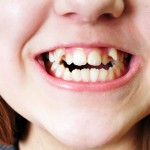
Anterior open bite where there is a lack of vertical contact between the upper an lower incisors can occur with any skeletal patters Class I, II, or III. While associated with digit sucking there are various theories regarding its cause, which has resulted in a wide range of treatments being advocated.
The aim of this review was to provide a comprehensive and updated synthesis evaluating the effectiveness of the correction of dental or skeletal open bite of growing individuals. A secondary objective was to identify deficient methodological points in the collected literature, and then suggest directions for future studies to be performed.
Methods
Searches were conducted in the PubMed, Embase, Cochrane Library, Web of Science, Scopus, Google Scholar, Scielo, Lilacs, ProQuest Dissertations, Theses Global ClinicalTrials.gov, the European Union Clinical Trials Register, and the Australian New Zealand Clinical Trials Registry databases.
Randomised (RCTs) and non-randomised controlled trials(nRCTs) involving patients who underwent orthodontic treatment to correct AOB and/or hyperdivergent facial pattern were considered. Two reviewers independently screened studies and abstracted data. Risk of bias was assessed with the Cochrane tools for RCTs with the MINORS tool being used for nRCTs. The main outcomes of interest were overbite or any vertical skeletal parameter concerning mandibular and palatal plane inclinations. A narrative summary was conducted the heterogeneity of appliances and therapies described.
Results
- 22 studies ( 3 RCTs 19 nRCTs) were included.
- A wide range of therapies and appliances were used:
- Fränkel regulator-4 (FR-4): with or without lip seal exercises (3studies);
- Open bite bionator (OBB): only or associated with high- pull headgear (4 studies);
- Posterior bite-blocks (PBB): passive splints of diverse thicknesses associated with vertical-pull chin cup (VPCC) magnetic or spring-activated appliances (9 studies);
- Maxillary expansion appliances (MEA): slow or rapid associated with VPCC (3 studies);
- Rapid maxillary intruder (RMI): combined with conventional (transpalatal and lingual arches) or alternative anchorage systems (maxillary posterior splint) (2 studies);
- Class II headgear appliances: high-pull activator and modified Thurow appliance (2 studies); and
- VPCC: as an exclusive approach (1 study).
Conclusions
The authors concluded:
A comprehensive and updated review regarding the effectiveness of the orthodontic therapy on the early correction of dental or skeletal open bite was provided. Despite large variability and methodological inaccuracies, specific inferences and directions for future studies were presented. Even though the methodological quality of the studies has been improving, additional efforts must still be directed to perform better and conclusive studies.
Comments
While this review has undertaken and extensive search strategy only 3 low quality RCTs have been identified as well 19 nRCTs. While the 19 nRCTs all had control groups the authors raise a number of important methodological issues with these studies. Consequently only a narrative summary of the included studies is provided.
This review covers the ground on an earlier Cochrane review update in 2014 by Lentini-Oliveira et al. That review also included 3 RCTs only 2 of which are included in this new review. Both reviews highlight to poor quality of the available evidence and call for high quality RCTs to conducted on the topic. The Cochrane reviews concluded:-
There is weak evidence that the interventions FR-4 with lip-seal training and palatal crib associated with high-pull chincup are able to correct anterior open bite. Given that the trials included have potential bias, these results must be viewed with caution. Recommendations for clinical practice cannot be made based only on the results of these trials. More randomised controlled trials are needed to elucidate the interventions for treating anterior open bite.
Links
Feres MF, Abreu LG, Insabralde NM, Almeida MR, Flores-Mir C. Effectiveness of the open bite treatment in growing children and adolescents. A systematic review. Eur J Orthod. 2015 Jul 1. pii: cjv048. [Epub ahead of print] Review. PubMed PMID: 26136439.
Lentini-Oliveira DA, Carvalho FR, Rodrigues CG, Ye Q, Hu R, Minami-Sugaya H, Carvalho LBC, Prado LBF, Prado GF. Orthodontic and orthopaedic treatment for anterior open bite in children. Cochrane Database of Systematic Reviews 2014, Issue 9. Art. No.: CD005515. DOI: 10.1002/14651858.CD005515.pub3.
Dental Elf – 23rd Aug 2011 – How stable is treatment for anterior open bite?

Anterior open bite: limited evidence for current treatment approaches http://t.co/8hhweFmbTr
Little evidence for current treatment approaches for anterior open bite http://t.co/8hhweFmbTr
Thanks Derek for taking the time to comment on our recent systematic review.
We currently have the second part of this project under evaluation in another orthodontic journal. This second part is titled “Effectiveness of the open-bite treatment when managing deleterious oral habits in growing children and adolescents. A systematic review and meta-analysis”. The quality of the available evidence, even though it was not great, allowed us to do a meta-analysis of the impact of crib therapy on controlling deleterious oral habits as a means to treat anterior open-bites in growing individuals.
Thanks Carlos, I will keep a look out for it and look at it when it is published.
Anterior open bite: little evidence for current treatment approaches http://t.co/8hhweFmbTr
Evidence limited for current treatments for Anterior open bite http://t.co/8hhweFmbTr
Don’t miss -Anterior open bite: limited evidence for current treatment approaches http://t.co/8hhweFmbTr
Evidence limited for current treatments for Anterior open bite http://t.co/6hWRn5oaz4 via @TheDentalElf